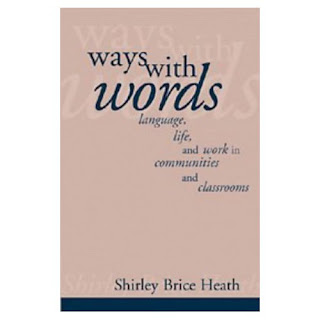
The question seems to be the building block for education in this accountability driven era. However, why and how questions are asked can differ from one social setting to another.
I just read an ethnographic study conducted from 1970 – 1975 by S.B. Heath. This study is a seminal work that was published in a book titled Ways with Words in 1983.
In this classic the researcher conducted her research in response to requests by African-American parents in her community and white teachers of the community school to help them find out why students where not succeeding academically and where turned off to school. The study talks about how the the changes resulting from the educational reforms of Brown v. Board and the E.S.E.A of 1965 (now known as NCLB) brought black students into schools with white teachers.
What struck me was that the research that was conducted then is still applicable today and it could still be affecting how well students from different backgrounds succeed in school.
The study examines reasons for questions in homes of working class Blacks, in the public school, and in the homes of the white teachers of the school.
The reasons for questions in the teachers homes and in the school were often questions the teacher already knew the answer to, sometimes questions the adult didn’t know the answer to, or veiled “directives or condemnations” of children’s behaviors. Often these white adults asked their children and their students to give information out of context. They might ask, “What color is that?” The questions the adults didn’t know the answer to were questions mostly about a child’s preference, “What do you want?” and the third type of question asked, “Why can’t things be simpler than they are?” was clearly rhetorical and considered the “polite” way to chastise a child.
In contrast, in the students homes, they were not asked questions that took objects and events out of context. Instead of three types of questions there where five types of questions in children’s homes.
1) Questions in children’s homes might ask a child to relate an object or event to another that they and the questioner both understood. (What’s that like?)
2) They could serve as a “story starter” (Did you see Maggie’s dog yesterday?)
3) An accusatory question (What’s that all over your face?) When asked a “condemnation” question students could either, bow their head and say nothing or tell a story or joke that would cause the questioner to “forget” why they asked the question.
4) A question of preference “What do you want?”
5) Or, a question that the questioner and the child both new the answer to. (What’s your name?) In this last situation the student is expected to give the the questioner the nickname that the questioner calls him or her and it is meant to affirm their relationship.
Needless to say, I thought a lot about the questions I asked my preschoolers today. I tried to be more balanced about the types of questions I asked but, I know I am part of a system. I asked kids to read words, tell me numbers, and describe the relative weights of objects. I also tried to ask, “What did you have for dinner last night? What word does that sound like? and Where were you when the police called about your sister?
I have seen all of the behaviors described by Heath to greater or lesser degree in my classroom. The best part of the study was Heath’s refusal in her description or her reporting to condemn the students or their parents way of using language. Her ideas about a “two-way path” for language understanding in schools and communities ties democratic ideals to academic research and education.
I have had a colleague tell me about her experience serving on a test review committee. When too many African-American boys got a question right on the test the question was deleted from the test. So my question is, are we asking the “right” questions?
